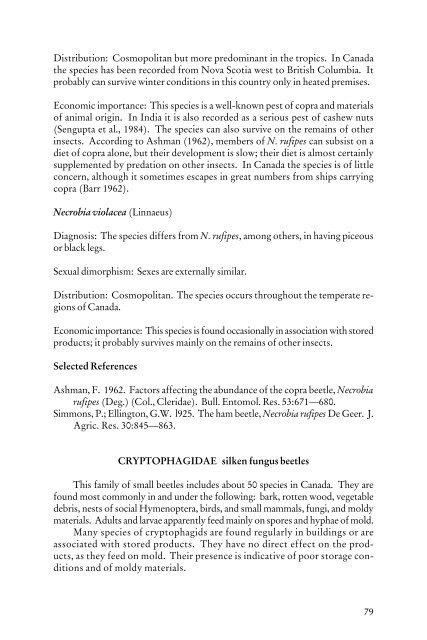Beetles Identification Guide
Beetles Identification Guide
Beetles Identification Guide
Create successful ePaper yourself
Turn your PDF publications into a flip-book with our unique Google optimized e-Paper software.
Distribution: Cosmopolitan but more predominant in the tropics. In Canada<br />
the species has been recorded from Nova Scotia west to British Columbia. It<br />
probably can survive winter conditions in this country only in heated premises.<br />
Economic importance: This species is a well-known pest of copra and materials<br />
of animal origin. In India it is also recorded as a serious pest of cashew nuts<br />
(Sengupta et al., 1984). The species can also survive on the remains of other<br />
insects. According to Ashman (1962), members of N. rufipes can subsist on a<br />
diet of copra alone, but their development is slow; their diet is almost certainly<br />
supplemented by predation on other insects. In Canada the species is of little<br />
concern, although it sometimes escapes in great numbers from ships carrying<br />
copra (Barr 1962).<br />
Necrobia violacea (Linnaeus)<br />
Diagnosis: The species differs from N. rufipes, among others, in having piceous<br />
or black legs.<br />
Sexual dimorphism: Sexes are externally similar.<br />
Distribution: Cosmopolitan. The species occurs throughout the temperate regions<br />
of Canada.<br />
Economic importance: This species is found occasionally in association with stored<br />
products; it probably survives mainly on the remains of other insects.<br />
Selected References<br />
Ashman, F. 1962. Factors affecting the abundance of the copra beetle, Necrobia<br />
rufipes (Deg.) (Col., Cleridae). Bull. Entomol. Res. 53:671—680.<br />
Simmons, P.; Ellington, G.W. l925. The ham beetle, Necrobia rufipes De Geer. J.<br />
Agric. Res. 30:845—863.<br />
CRYPTOPHAGIDAE silken fungus beetles<br />
This family of small beetles includes about 50 species in Canada. They are<br />
found most commonly in and under the following: bark, rotten wood, vegetable<br />
debris, nests of social Hymenoptera, birds, and small mammals, fungi, and moldy<br />
materials. Adults and larvae apparently feed mainly on spores and hyphae of mold.<br />
Many species of cryptophagids are found regularly in buildings or are<br />
associated with stored products. They have no direct effect on the products,<br />
as they feed on mold. Their presence is indicative of poor storage conditions<br />
and of moldy materials.<br />
79
















